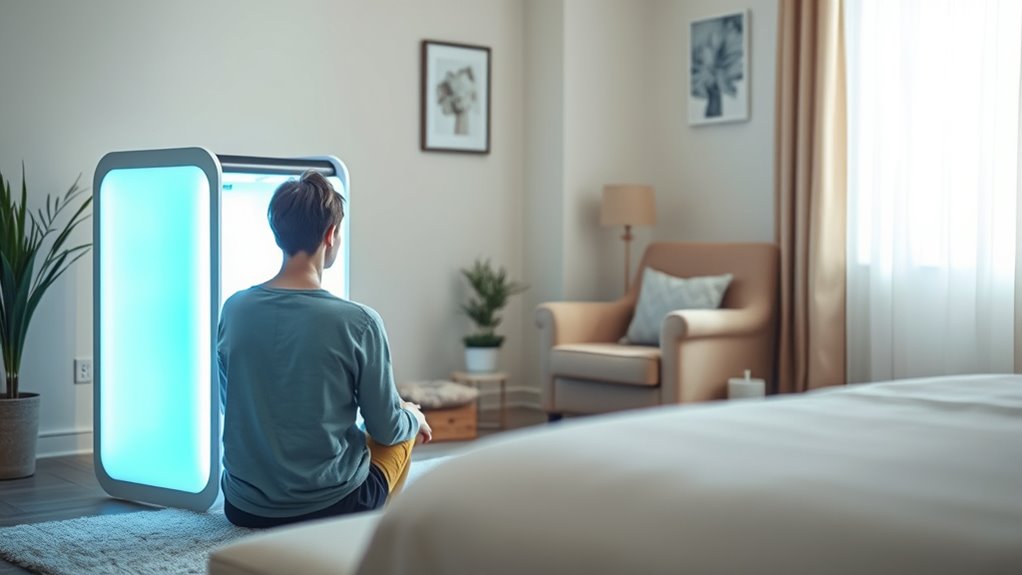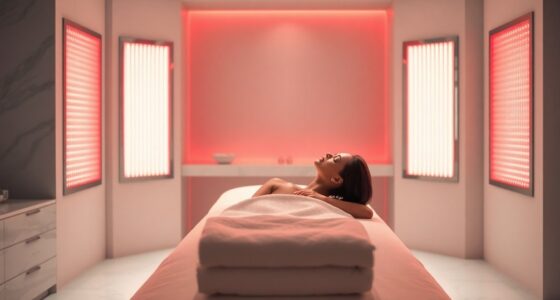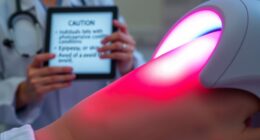Light therapy can effectively treat both seasonal affective disorder (SAD) and nonseasonal depression by helping your internal clock stay on schedule and boosting mood-enhancing chemicals like serotonin. It provides a consistent light source during darker months for SAD and can help stabilize circadian rhythm disruptions in nonseasonal depression. While it’s more commonly associated with SAD, its benefits extend beyond seasons. If you want to discover how it works for different conditions, keep exploring further.
Key Takeaways
- Light therapy is a primary, evidence-based treatment for Seasonal Affective Disorder (SAD) due to reduced natural light in winter.
- For nonseasonal depression, light therapy can help regulate circadian rhythms but is often part of a broader treatment plan.
- SAD responds well to daily light exposure during darker months, directly targeting seasonal light deficiency.
- Nonseasonal depression may require combined therapies; light therapy addresses underlying biological rhythm disruptions.
- Consistent use of light therapy supports mood improvement in both SAD and some cases of nonseasonal depression by stabilizing brain chemistry.

Light therapy has become a popular treatment option for those struggling with mood disorders, especially seasonal affective disorder (SAD). This therapy involves exposure to bright artificial light, which can considerably influence your brain’s internal processes. One key way light therapy works is by helping regulate your circadian rhythm, the natural internal clock that governs your sleep-wake cycle. During the darker months, your exposure to natural light diminishes, causing disruptions in this rhythm. By providing a consistent light source, you help reset your internal clock, making it easier for you to fall asleep at night and wake up feeling refreshed. This regulation can reduce symptoms of fatigue and improve overall mood, which are common struggles for those with SAD.
Light therapy helps reset your internal clock, easing fatigue and boosting mood during darker months.
In addition to circadian rhythm regulation, light therapy also plays a role in neurotransmitter modulation. Neurotransmitters like serotonin are critical for mood stability and emotional well-being. When your exposure to natural light drops, your serotonin levels tend to decrease, contributing to feelings of depression and lethargy. Light therapy stimulates the production of serotonin, resulting in a more balanced mood and increased motivation. This effect is especially beneficial during the winter months when sunlight is scarce, and your brain’s chemistry can become imbalanced. You might notice a boost in your energy levels and a lift in your overall outlook, which can be transformative for those suffering from SAD.
When it comes to nonseasonal depression, the picture is more complex. While light therapy can still help, especially in cases where a person’s circadian rhythm is disrupted, it’s often used as part of a broader treatment plan. Nonseasonal depression isn’t solely driven by light exposure; it involves a variety of biological, psychological, and social factors. Nevertheless, by improving circadian rhythm regulation and neurotransmitter function, light therapy can provide some relief, especially for individuals whose depression is linked to sleep disturbances or irregular biological rhythms. It’s important to understand that the effectiveness of light therapy for nonseasonal depression varies from person to person. Some may experience considerable improvements, while others might need additional treatments like medication or psychotherapy.
In both types of depression, consistency is key. Regular daily exposure to the prescribed light can help sustain the benefits, reinforcing your brain’s natural rhythms and chemical balance. So, whether you’re battling seasonal changes or persistent mood challenges, light therapy offers a non-invasive, accessible option to support your mental health by targeting core biological mechanisms like circadian rhythm regulation and neurotransmitter modulation.
Frequently Asked Questions
Can Light Therapy Be Used Alongside Medication Safely?
Yes, you can safely combine light therapy with medication, but it’s important to consult your healthcare provider first. This combination therapy can enhance your treatment, but your doctor will need to oversee your progress to guarantee safety and effectiveness. Regular treatment monitoring helps prevent potential side effects and adjusts your plan as needed, giving you the best chance of relief while minimizing risks. Always follow your doctor’s advice for safe, effective care.
How Long Does It Typically Take to See Improvements?
You’ll typically notice symptom improvement within one to two weeks of starting light therapy, though the timing of results can vary. Consistency is key, and some people see quicker improvements, often within a few days. To maximize effectiveness, use the light box daily as recommended. If you don’t see progress after a few weeks, consult your healthcare provider to adjust your treatment plan.
Are There Any Long-Term Risks Associated With Light Therapy?
Like Icarus flying too close to the sun, you might worry about long-term risks of light therapy. Generally, it’s safe when used properly, but you should consider ocular safety and skin sensitivity. Prolonged or intense exposure could cause eye strain or skin irritation. To avoid problems, follow your healthcare provider’s guidance, and get regular eye check-ups. This way, you can enjoy the benefits without risking your health.
Is Light Therapy Effective for Children or Teenagers?
Light therapy can be effective for children and teenagers, but you should prioritize pediatric safety. It’s crucial to consult a healthcare professional to guarantee proper guidance. Teen compliance might be a challenge due to the routine, but with clear instructions and supervision, teens can adhere to the treatment. Always monitor for side effects and adjust the protocol as needed, making sure the therapy is safe and effective for younger individuals.
Can Light Therapy Cause Side Effects or Worsen Symptoms?
Like a delicate dance with sunlight, light therapy can sometimes tip the balance, causing side effects. You might notice increased light sensitivity or eye strain, making your eyes feel weary or your mood waver. While rare, some people experience headaches or agitation. To avoid worsening symptoms, start gradually, use the correct light intensity, and consult your doctor if you notice discomfort, ensuring your journey toward wellness remains gentle and safe.
Conclusion
While light therapy offers hope for brighter days, it’s gentle guidance rather than a cure-all. Embrace it as a supportive step on your journey, knowing that each small moment of hope can help you find your way through darker times. Remember, even the faintest glimmer can inspire a new dawn. Be kind to yourself, and trust that with patience and care, brighter days are gently on the horizon.








